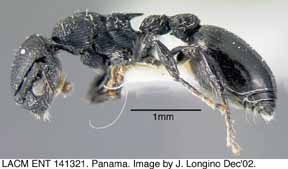

Formicidae, Hymenoptera, Insecta, Arthropoda, Animalia
|
|
|
Image catalogue, worker (click here).
Range
Brazil (Amapá, Amazonas, Pará, Rondonia, Roraima), Bolivia, Peru, Guyana, Suriname, Panama, Costa Rica.
Description of worker
Worker measurements (n=1, Panama): HW 1.001 (1.001-1.069, n=3), HL 0.939, SL 0.622, EL 0.257, MeL 1.203, MeW 0.706, PrW 0.539, PrL 0.273, PrS 0.196, PrT 0.469, MTL 0.615, PtL 0.379, PtW 0.349, PpW 0.505, PtH 0.292, AL 1.262, AW 1.073, ASW 0.023.
Head roughly circular in outline; frontal carina ends on the torulus, forming notch ventrally that receives inner basal projection of scape; face to vertex margin with evenly dispersed discrete foveae; interspaces subgranular with fine areolate etchings; clypeus at level of antennal insertions abruptly bent ventrad; upper margin of clypeus and entire clypeal bend longitudinally rugose, 10-12 rugae between antennal insertions; rugae diverge on lower portion of clypeus, leaving median unsculptured depression at lower margin; genae with closely-spaced foveae; genal bridge longitudinally rugose; mandible with coarse longitudinal striae; in anterior view, eyes asymmetrically convex, skewed ventrad; scape flattened, as wide as or wider at base than at apex, lateral margins thickened, especially at base, such that cross-section roughly hour-glass shaped; broad flat surface of scape finely areolate, lateral margin with coarse rugae; margin of vertex angulate but not carinate or crenate; vertex with some coarse striae radiating from the occiput, especially laterally, otherwise smooth and shiny.
In dorsal view, mesonotum with small lateral lobes usually with straight lateral margins parallel to the longitudinal body axis, posteriorly squared-off so that they are hardly tooth-like, ending at the anterior margin of the propodeal suture; occasionally subacute and slightly tooth-like; propodeal suture a broad, shallow trough; dorsal face of propodeum with anterolateral lobes distinct, evenly convex to subrectangular, with variably developed posterolateral angle; pronotum foveate rugose, rugae becoming somewhat more longitudinally parallel on mesonotum; propodeal suture with regular parallel striae which continue onto dorsal face of propodeum; posterior face of propodeum perpendicular to dorsal face, slightly concave; usually completely smooth and shining except for one or two transverse striae dorsally, between bases of propodeal spines (one specimen from Peru with longitudinal striae continuing from dorsal face onto posterior face); parallel longitudinal striae cover lateral pronotum, anepisternum, katepisternum, and lateral propodeum; those on pronotum and anepisternum usually larger than those on katepisternum and propodeum; coxae striate; hind femur strongly swollen medially, spindle-shaped; posterior surface of forefemur faintly obliquely striate (of variable strength); remaining femur surfaces smooth.
Ventral margin of petiole concave to nearly flat, ending anteriorly in a variably developed, blunt, right-angled tooth; anterodorsal face of petiole longitudinally striate, irregularly reticulate-rugose, transversely striate, or nearly smooth; posterodorsal face reticulate-rugose; postpetiole with a long, gently sloping anterior face, a broad, rounded summit near the posterior margin, and a steeply sloping posterior face; ventral margin of postpetiole short, with a prominent, acute anterior tooth; anterior face of postpetiole longitudinally striate, posterior face reticulate-rugose; anterior portion of first gastral tergite with largely straight and parallel, occasionally anastomosing striae; striae fade to finely areolate microsculpture and widely-dispersed very small puncta at approximately half AL, areolate microsculpture gradually fades posteriorly (specimens from Rondonia and Peru with somewhat sharper, non-anastomosing striae and generally shinier surface); anterolateral portion of first gastral sternite with fine, longitudinal striae, these fading medially and posteriorly; remainder of sternite smooth and shiny with uniformly distributed, sparse puncta; second gastral tergite nearly smooth medially, with faint, finely areolate microsculpture becoming stronger laterally.
Specimens from Central America and central to eastern Amazonia with 0-4 stiff setae on disc of face; 0.09-0.11mm long; sparse stiff setae on mesosomal dorsum, to 0.09mm; stouter setae on petiole and postpetiole, to 0.18mm; first gastral tergite with 0-4 stiff erect setae, to 0.10mm long, and sparse, very short, appressed pubescence emanating from puncta; specimens from Rondonia and Peru with setae relatively longer, more abundant, and more flexuous, especially on anterior portion of first gastral tergite; color shining black, with appendages gradually fading to dark brown distally.
Description of queen
Queen measurements (n=1, Panama): HW 1.07, HL 1.06, SL 0.62, EL 0.27, MeL 1.53, MeW 0.90, MTL 0.71, AL 1.56, AW 1.18.
Similar to worker in most respects; pronotum, mesoscutum, axillae, and scutellum coarsely foveate, with a few irregular rugae on scutellum and extending onto axillae; propodeum essentially as in worker.
Natural History
This rarely-collected species occurs in the high canopy of lowland rainforest trees. Some collections have come from insecticidal fogging of the canopy (Luehea seemannii in Panama, the Erwin fogging program in Peru). Weber (1938) obtained the winged queen of P. guianensis from the stomach of Bufo marinus. An LACM specimen is a queen head capsule collected from the feces of a silky anteater (Cyclopes). The only known nest collection was by W. L. Brown, Jr., from near Manaus. The collection contains a dealate queen and a male.
Types and Synonymy
Meranoplus attenuatus F. Smith, 1876:610, pl. 11, fig. 9. Holotype queen: Brazil, Pará [BMNH].
Meranoplus puncticeps F. Smith, 1876:610-1, pl. 11, fig. 10. Holotype worker: Brazil, Pará [BMNH]. Synonymy by Forel, 1911:262.
Cataulacus attenuatus: Mayr, 1886:364.
Cataulacus puncticeps: Mayr, 1886:364.
Procryptocerus attenuatus: Emery, 1887:470; Kempf, 1964:436-437.
Procryptocerus puncticeps: Emery, 1887:470.
Procryptocerus subpilosus attenuatus: Forel, 1911:262; Kempf, 1951:61-62.
Procryptocerus goeldii guianensis Weber, 1938:208. Holotype alate queen: Guyana, Forest Settlement, Mazaruni River (Weber) [MCZC]. Synonymy by Kempf, 1964:436-437.
Page author:
John T. Longino, The Evergreen State College, Olympia WA 98505 USA. longinoj@evergreen.edu
Date of this version: 6 December 2002.